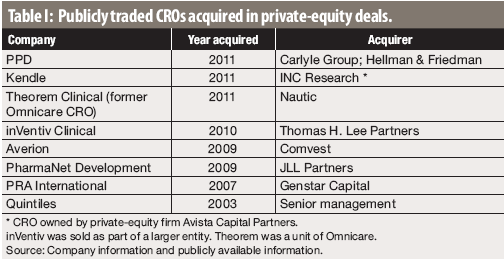Strategies for Value Creation in the Biopharmaceutical Industry
PTSM: Pharmaceutical Technology Sourcing and Management
Improving R&D productivity, life-cycle management, and operational efficiency are key approaches for enhancing growth prospects.
A recent report by The Boston Consulting Group (BCG) examined the performance of the biopharmaceutical industry in comparison to other industries with respect to total shareholder return (TSR) as a measure of value creation during the five-year period of 2006–2010 (1). The report concluded that the biopharmaceutical industry lags other industries in terms of value-creation and that there is opportunity to improve growth prospects with sector-specific strategies for large-cap biopharmaceutical companies, emerging biopharmaceutical companies, and generic-drug companies.
Benchmarking the biopharmaceutical industry
BCG examined 19 industries, manufacturing- and service-based, and found that the biopharmaceutical industry ranked last in terms of TSR. TSR is a measure of the total annual increase in value given to a shareholder. TSR measures the change in a company’s market value (i.e., often comprising of earnings and the share price/earnings [P/E] multiple) plus its free-cash flow (i.e., dividend yield and changes in net debt and the number of outstanding shares) (1). In compiling the TSR of the biopharmaceutical industry, BCG examined 43 companies with market valuation greater than $5 billion. Annual average TSR across all 19 industries was 6%, well below historical annual averages of 10%, but was only 0.7% in the biopharmaceutical industry. Despite the low ranking overall, there were some bright spots for individual companies. The top five performers in the biopharmaceutical sector had an annual average TSR of more than 17% in the five-year period of 2006–2010 (1).
Examining biopharmaceutical industry performance
To examine these rankings in more detail, BCG applied a proprietary system methodology to identify the drivers of TSR performance in the three major sectors in the biopharmaceutical industry: large-cap, emerging, and generic-drug companies. For purposes of this analysis, large-cap biopharmaceutical companies are companies with market capitalization of $30 billion or more, and emerging biopharmaceutical companies have a capitalization between $5 billion and $30 billion. Generic-drug companies are defined as companies that derive more than 60% of their sales from generic drugs. Overall, although sales growth remained strong for the biopharmaceutical industry during the five-year period of 2006–2010, expectations for future growth declined significantly. For example, P/E ratios for the large-cap biopharmaceutical companies declined from multiples of 35 times price to earnings in 2000 to 11 times price to earnings in 2010. More troubling is that the average return on investment (ROI) in R&D for new products is below the cost of capital, making R&D value-destroying (1). Near-term growth was the weakest in large-cap biopharmaceutical sector (7% per year), strongest in the generic-drug sector (21%), and the emerging biopharmaceutical was in between (11%).
The factors contributing to better performance, as measured by valuation multiples, in each sector differed. Among large-cap biopharmaceutical companies, the key drivers are R&D productivity, operational efficiency and margins, financial policy, and the ability to maximize the sales value of the product portfolio before and after loss of exclusivity. For emerging biopharmaceutical companies, the key drivers were margin, R&D productivity, debt ratio, and sales growth. For generic-drug companies, the key drivers are scale and financial stability, particularly in the debt/enterprise value ratio.
The large-cap biopharmaceutical sector performed poorly on average, with a flat 0% TSR over the five-year period. For companies that performed better, four factors contributed to a higher TSR: improved R&D productivity, operational efficiency and margins, financial policy, and the ability to maximize the sales value of the product portfolio before and after loss of exclusivity. In measuring the net value of R&D as a percentage of enterprise value, the report found that in 2010, five companies–Amgen, Bristol-Myers Squibb, Celgene, Genentech, and Gilead Sciences–had positive ROI for R&D while five companies–AstraZeneca, Merck & Co., Pfizer, GlaxoSmithKline, and Eli Lilly had below average performance. In 2011, only two companies–Bristol-Myers Squibb and Pfizer–performed above average in ROI on R&D and seven companies–Amgen, GlaxoSmithKline, Merck & Co., Gilead Sciences, AstraZeneca, Celgene, and Eli Lilly–had below average ROI on R&D. To improve R&D output, BCG advises strategies to reduce bureaucracy in R&D and facilitate decision-making for “go/no” projects both operationally and culturally.
The report also found that companies that treat life-cycle management as part of product development proactively rather than defensively when confronting loss of exclusivity perform better. The report identifies four key strategies: maximizing patent life through technical, legal, and regulatory means; driving demand and scale immediately before patent expiry; progressively lowering the cost base for the product; and limiting revenue decline due to loss of exclusivity by preserving or replacing lost volumes by lowering prices in certain segments while maintaining a premium price in other segments that support the product (1). For example, the report estimates that as much as 40% of blockbusters’ potential revenue maintenance can come from geographic markets outside the established markets in the United States and five top Western European markets (1).
For emerging biopharmaceutical companies, the key drivers for creating value were margins, R&D productivity, debt ratio, and sales growth. Crucial for these companies is to have a follow-on strategy for a recently launched drug or licensed drug. For generic-drug companies, the key drivers are scale and financial stability, particularly in the debt/enterprise value ratio. Generic-drug companies often face a “land grab” situation, in which companies are building scale to win market share but need to do so without becoming financially extended. Financial stability tends to favor the larger generic-drug companies that have available funds for investing in new growth opportunities (1).
Reference
1. M. Ringel, C. Foley, O. Wierzba, “The 2011 Health Care Value Creators Report: Strength in the Storm: How Biopharmaceutical and Medical Technology Companies Can Create Value in a Challenging Business Environment” (The Boston Consulting Group, Dec. 2011).


